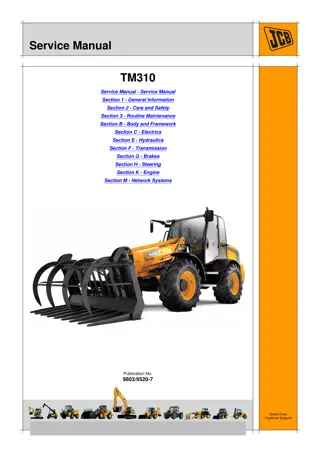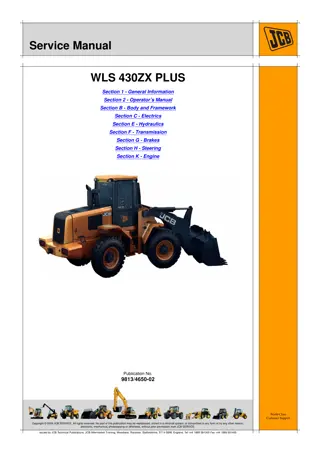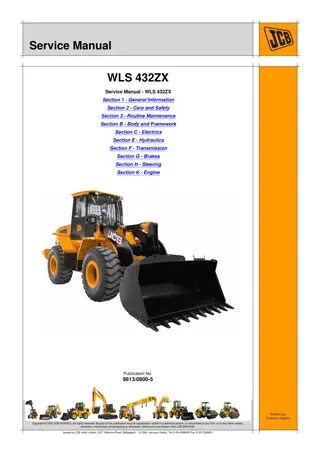
JCB TM320 Tier 4i Telescopic Wheeled Loader Service Repair Manual Instant Download (From 2090867 To 2090999)
Please open the website below to get the complete manualnn//
Download Presentation

Please find below an Image/Link to download the presentation.
The content on the website is provided AS IS for your information and personal use only. It may not be sold, licensed, or shared on other websites without obtaining consent from the author. Download presentation by click this link. If you encounter any issues during the download, it is possible that the publisher has removed the file from their server.
E N D
Presentation Transcript
Foreword The Operator's Manual You and others can be killed or seriously injured if you operate or maintain the machine without first studying the Operator's Manual. You must understand and follow the instructions in the Operator's Manual. If you do not understand anything, ask your employer or JCB dealer to explain it. SERVICE MANUAL Do not operate the machine without an Operator's Manual, or if there is anything on the machine you do not understand. Treat the Operator's Manual as part of the machine. Keep it clean and in good condition. Replace the Operator's Manual immediately if it is lost, damaged or becomes unreadable. LOADER TM320 Contents 01 - Machine 03 - Attachments, Couplings and Load Handling EN - 9813/2350 - ISSUE 5 - 01/2017 06 - Body and Framework 09 - Operator Station 12 Conditioning (HVAC) - Heating, Ventilating and Air- 15 - Engine 18 - Fuel and Exhaust System 21 - Cooling System 24 - Brake System This manual contains original instructions, verified by the manufacturer (or their authorized representative). 25 - Steering System 27 - Driveline 30 - Hydraulic System Copyright 7-01-06 JCB SERVICE All rights reserved. No part of this publication may be reproduced, stored in a retrieval system, or transmitted in any form or by any other means, electronic, mechanical, photocopying or otherwise, without prior permission from JCB SERVICE. 33 - Electrical System 72 - Fasteners and Fixings 75 - Consumable Products www.jcb.com 78 - After Sales
15 - Engine 30 - Valve 00 - General 00 - General Introduction Introduction .................................................. 15-113 Technical Data ............................................. 15-114 Component Identification ............................. 15-115 Operation ..................................................... 15-117 Adjust .......................................................... 15-117 Remove and Install ..................................... 15-120 The valve train system opens and closes the valves with correct timing in relation to the piston movements. Each push rod has one end in a valve tappet and the other end under a rocker arm, or as applicable. The adjusting screw has a ball shaped end that locates in the push rod. The adjusting screw is used for setting the valve clearance. The valves extend through the cylinder head. There are no sleeves or valve guides in the cylinder head. The valves are made from a special metal to provide a long service life. Damaged or worn valves cannot be lapped or reground and must be replaced with new ones. Each valve stem has an oil seal. The Valve seat inserts are pressed into the cylinder head. The seat inserts are also made from a special metal to provide for a long service life. Damaged or worn seat inserts can be removed and replaced with new ones. 15 - 113 9813/2350-5 15 - 113
15 - Engine 30 - Valve 00 - General Technical Data Table 92. Inlet and Exhaust Valve Data Max lift Inlet Max lift Exhaust Inlet opens (top of ramp) 6 BTDC Inlet closes Exhaust opens Exhaust closes Valve stem diameter - Inlet - Exhaust Valve spring free length Valve guide bore diame- ter - min - max Valve face angle - Inlet - Exhaust Valve length Valve sealing 9.64mm @ 101 ATDC 9.84mm @ 115 BTDC 28 ATDC 41 BTDC 6 ATDC 6.928 6.943mm 6.918 6.933mm 51.1mm 6.958mm 6.973mm 60.5 45.17 131.9 132.4mm Stem seal with sealing washer Valve head depth (below cylinder head surface) - Inlet - Exhaust Valve rim thickness Valve Clearances (en- gine cold) - Inlet - Exhaust 0.89 1.39mm 0.95 1.45mm 2.98 3.38mm (1) 0.15 0.21mm 0.43 0.49mm (1) (1) The values refer to the tappet adjuster end of the valve rockers. 15 - 114 9813/2350-5 15 - 114
https://www.ebooklibonline.com Hello dear friend! Thank you very much for reading. Enter the link into your browser. The full manual is available for immediate download. https://www.ebooklibonline.com
15 - Engine 30 - Valve 00 - General Component Identification Figure 188. 6c 6b 6a7 9 10 15 3 5 16 1 4 2 3a 745700 1 3 4 6a 6c 7 9 11 13 Camshaft drive gear Camshaft Tappets (x8) Rockers - inlet (x4) Adjusting screws (x8) Rocker shaft Bridge pieces (x8) Retainer (x16) Oil seal - valve stems (x16) 2 3a 5 6b 6d 8 10 12 14 Crankshaft gear Lobes Push rods (x8) Rockers - exhaust (x4) Swivel tip - rockers Wave washers (x8) Valve springs (x16) Collets (x32) Valve seat inserts (x16) 15 - 115 9813/2350-5 15 - 115
15 - Engine 30 - Valve 00 - General 15 17 Inlet valves (x8) Valve stem 16 Exhaust valves (x8) Cross Sectional View Figure 189. 17 6c 11 12 8 10 13 6b 6a 9 6d 745930 14 6a 6c 8 10 12 14 Rockers - inlet (x4) Adjusting screws (x8) Wave washers (x8) Valve springs (x16) Collets (x32) Valve seat inserts (x16) 6b 6d 9 11 13 17 Rockers - exhaust (x4) Swivel tip - rockers Bridge pieces (x8) Retainer (x16) Oil seal - valve stems (x16) Valve stem 15 - 116 9813/2350-5 15 - 116
15 - Engine 30 - Valve 00 - General Operation Adjust Special Tools Tool Category Special Tool The camshaft drive gear is driven by the crankshaft gear at half the speed of the crankshaft. Camshaft lobes, two for each cylinder, (operating exhaust and inlet valves) actuate the valve tappets. Description Part No. Qty. Crankshaft Turning Tool (95.25mm PCD)- JCB 4 Cylinder Ecomax and Dieselmax Valve Clearance Service Kit 892/01147 1 When the camshaft rotates the cam lobes act on the tappets. The push rods act on the rockers which pivot on the camshaft, depressing two valves at the same time via the bridge piece. The screw is self locking in the rocker by means of a tapered thread. Wave washers act like springs to keep the rockers in their correct positions along the camshaft and prevent them contacting one another. The rockers incorporate a swivel tip to ensure alignment with the bridge piece. This prevents excessive wear. Special Tool 892/01380 1 Engine Position Each valve has a compression spring. The function of the spring is to close the valve and at the same time return the rocker arm and push rod to ensure that the tappets follow the camshaft lobes. The spring is located on the valve stem by a retainer and split collets. The engine needs to be set to two different positions to measure and adjust all of the valves. The graphics show which valves are applicable at which engine position. 1. Make sure that the engine is safe to work on. If the engine has been running, let it cool before you start the service work. 2. Get access to the engine. 3. Remove the tappet covers. Refer to (PIL 15-42). 4. Put the indicator pins into the holes inside the tappet adjusters for cylinder number 4. Make sure that the pins do not fall into the engine. 5. Use the crankshaft turning tool to turn the engine crankshaft clockwise. Stop turning the crankshaft when one indicator pin starts to move up after the other pin has moved down. This is the position where the exhaust valve is almost closed and the inlet valve is just starting to open. Special Tool: Crankshaft Turning Tool (95.25mm PCD)- JCB 4 Cylinder Ecomax and Dieselmax (Qty.: 1) Special Tool: Valve Clearance Service Kit (Qty.: 1) 6. Put a mark on the crankshaft pulley at the 12 o'clock position. 15 - 117 9813/2350-5 15 - 117
15 - Engine 30 - Valve 00 - General Figure 190. Figure 192. 360 Degree Position A 360 T7 2B 4B 1A 2A 1A Exhaust valve-Cylinder 1 2A Exhaust valve-Cylinder 2 2B Inlet valve-Cylinder 2 4B Inlet valve-Cylinder 4 T8 T8 Valve Clearances The procedure describes how to measure and, if necessary, adjust one valve clearance. The procedure for all the valves is the same. Do the procedure for the correct valves at each of the two engine positions. Remember you must remove the valve clearance service tools before you turn the engine crankshaft. A T7 Crankshaft turning tool T8 Indicator pins (obtain locally) 12 o'clock position 7. Turn the engine crankshaft 90 degrees clockwise. Important: The engine must be cold before you measure or adjust the valve clearances. 8. Measure and, if necessary, adjust the clearances for the correct valves. 1. Install the adaptor plate in the correct position on the rocker cover using the screws A. Figure 191. 90 Degree Position 2. Make sure that the crankshaft is in the correct position. 3. Put the adaptor sleeve on the correct valve tappet adjuster screw. 90 4. Push the lock bar into the correct valve tappet adjuster screw. 1B 3B 5. Tighten the lock bar by turning it with your hand. 3A 4A 6. Assemble the DTI support and DTI. 1B Inlet valve-Cylinder 1 3A Exhaust valve-Cylinder 3 3B Inlet valve-Cylinder 3 4A Exhaust valve-Cylinder 4 7. Push and then pull the lock bar in the direction of the arrows X and Y. Do this until you are sure that the lock bar is correctly installed and oil is moved away from the cam follower and push rod. 9. Remove the valve clearance service tools. Turn the engine crankshaft 360 degrees clockwise. Use the mark on the crankshaft pulley as a reference. 8. Important: Apply a side force on the lock bar at the same time as pushing and pulling. This prevents the rocker moving along the rocker shaft and giving a false reading on the DTI. Apply a force to the left on the exhaust valve tappets and to the right on the inlet valve tappets. 10. Measure and, if necessary, adjust the clearances for the correct valves. 15 - 118 9813/2350-5 15 - 118
15 - Engine 30 - Valve 00 - General Figure 193. Figure 194. T1 C T5 X A B T4 Y A T3 T2 T6 A T1 Dial Test Indicator (DTI)(obtain locally) T2 Adaptor plate (part of valve clearance service kit) T3 Adaptor sleeve (part of valve clearance service kit) T4 Lock bar (part of valve clearance service kit) T5 DTI Support (obtain locally) Screws B C T6 Spanner open ended (obtain locally) Tappet adjusters Rockers 9. Pull the lock bar in the direction of arrow Y and turn the DTI to zero. 10. Push the lock bar in the direction of arrow X and record the DTI indication. 11. Compare the valve clearance measurement with the correct clearances. If an adjustment is necessary: 11.1. Turn the tappet adjuster using an open ended spanner on the adaptor sleeve. Turn the sleeve clockwise to reduce the clearance and counterclockwise to increase the clearance. 11.2. Important: The tappet adjusters are set in position by thread friction with the rockers. Make sure that the torque to turn the tappet adjusters is more than the minimum necessary. If any of the adjusters show a lower torque value then the adjuster and its related rocker must be replaced. 15 - 119 9813/2350-5 15 - 119
15 - Engine 30 - Valve 00 - General Remove and Install Figure 195. Valve Stand Special Tools Tool Category Special Tool Description Part No. Qty. Valve Stem Seal Installation Tool 892/01152 1 EXHAUST EXHAUST EXHAUST INLET INLET INLET Before Removal CYL. 1 CYL. 2 CYL. 3 1. This procedure requires service parts. Make sure you have obtained the correct service parts before you start, refer to Parts Catalogue. Remove 2. Make sure that the engine is safe to work on. If the engine has been running, let it cool before you start the service work. 1. Use a spring compressor tool to compress each valve spring and remove the collets. Make sure that the springs are compressed squarely. 3. Get access to the engine. Figure 196. 4. Remove the thermostat, refer to (PIL 21-12). B 5. Remove all of the fuel injector pipes, refer to (PIL 18-96). 6. Remove the rocker cover, refer to (PIL 15-42). 7. Remove the fuel injectors, refer to (PIL 18-18). 8. Remove the rocker assembly, refer to (PIL 15-42). A 9. Remove the exhaust manifold, refer to (PIL 18-24). 10. Remove the inlet manifold, refer to (PIL 18-24). A Spring compressor tool B Collets 11. Remove the cylinder head assembly from the cylinder block, refer to (PIL 15-06). 2. Remove the spring compressor tool and lift off the retainer and valve spring. 12. Measure the valve recession with a suitable DTI (Dial Test Indicator). Clean the carbon deposits from a small area of the valve heads for location of the DTI probe. If the valve recession is outside the serviceable limits, it is advisable to obtain a new or reconditioned cylinder head assembly, refer to Technical Data (PIL 15-06). Figure 197. C D 13. To aid removal and replacement, use a wooden valve stand to retain the valves after removal. Add labels to make sure that the valves are correctly replaced. C Retainer D Valve spring 15 - 120 9813/2350-5 15 - 120
15 - Engine 30 - Valve 00 - General 3. Turn the cylinder head on its side and withdraw the inlet valves and exhaust valves as shown. If there is evidence of wear or damage to the valves, guides or seats, it is advisable to obtain a new or reconditioned cylinder head assembly. Figure 198. Before Installation G 1. Position the cylinder head upside down in a suitable jig or fixture. 2. Make sure that all items are clean and free from damage and corrosion. E F 3. Install the injectors into the cylinder head to do a trial check of the nozzle protrusion. Note the relative positions for the injectors, and then remove the injectors for installation at a later stage. Installation 1. The installation procedure is the opposite of the removal procedure. Additionally do the following steps. E Cylinder head F Inlet valves G Exhaust valves 2. Install the new valve stem seals as shown. Use the installation tool to avoid damaging the seals. Pre-assemble the seal into the tool. Locate the tool over the valve guide and gently press the seal into place. Lubricate the seal with P80 fluid. Special Tool: Valve Stem Seal Installation Tool (Qty.: 1) 4. When removing, note the respective position of each valve. Use a suitable valve stand to keep the valves together and identify them with their respective cylinder. Note: The exhaust valves have smaller diameter heads. 5. Remove the valve stem seals. Discard the seals. Figure 199. 3. With the cylinder head on its side, insert the inlet valves and exhaust valves as shown. Make sure that the valves are installed in the correct positions. Lubricate the valve stems with clean engine oil before assembly. Carefully push the end of the valve stem through the stem seals. J H 4. Install the valve springs on to the valve stems, together with a retainer. Use the spring compressor tool to compress each valve spring and insert the collets. Make sure that the collets are correctly seated in the valve stem grooves, before you remove the spring compressor tool. After Installation 1. Tap the valve stems in turn using a rubber mallet top fully seat the valves. H Valve stem seals J Punch tool Inspection 1. Carefully clean the carbon deposits from the valves, take care not to damage the valve seats. 2. Check that the valves and valve seats are not cracked, burnt or damaged. 3. Check the valve stems and valve guides for wear, refer to Technical Data (PIL 15-30). 15 - 121 9813/2350-5 15 - 121
15 - Engine 36 - Piston 00 - General Component Identification Figure 200. A B C D E A F G F A Piston B Connecting rod C Oil control ring D Piston ring - compression No.1 E Piston ring - compression No.2 F Retaining circlips G Piston pin 15 - 133 9813/2350-5 15 - 133
15 - Engine 36 - Piston 00 - General Operation The groove around the diameter of the upper main bearing shells allows oil transfer to an oil jet located in the crankcase bearing saddle. Jets are installed at the main bearing positions. top of the pistons. Oil spray also enters the small end bearing bushes via a feed hole on the top of each connecting rod. Note: On turbocharged engines additional J-jets are installed. Oilways connect the J-shaped jets fixed to the crankcase at the underside of each cylinder bore. The jets spray oil directly to the under side of the pistons effectively transferring heat away from the Figure 201. 3 4 2 1 1 6 2 5 1 Groove 3 Pistons 5 Crankshaft 2 Oil jet 4 Bearing bushes 6 J shaped jets 15 - 134 9813/2350-5 15 - 134
15 - Engine 36 - Piston 00 - General Check (Condition) Calibrate 1. Check the piston for signs of damage and excessive wear. Measure the piston skirt diameter, piston pin bore and the clearance in the piston ring grooves to confirm they are within service limits. Refer to Piston, Technical Data (PIL 15-36). Piston Height Measurement Above Cylinder Block- DTI Method Refer to engine, piston, technical data, (PIL 15-36-00). In the event of sufficient liquid entering the engine, a hydraulic lock can occur. This may result in bending of one or more of the connecting rods. Bending of the connecting rod(s) can occur even when the engine is cranked by the starter motor. 2. Check the piston pin for signs of damage and excessive wear. Measure the pin diameter to confirm it is within service limits. Refer to Piston, Technical Data (PIL 15-36). The connecting rod small end bearing bush is not renewable. If the small end bearing bush is damaged or worn the connecting rod must be renewed as a complete assembly. Bending of the connecting rod may be very slight and can be checked by carrying out this procedure prior to a full strip down: 1. With the cylinder head removed, make sure the surface of the engine block and piston are clean. 2. Zero a DTI (Dial Test Indicator) on the top face of the cylinder block adjacent to the area on the piston to be measured. The aim of the procedure is to use the DTI to take a measurement across 2 locations on the piston that are on the axis of the gudgeon pin. This will be towards the front and rear of the engine. 3. Rotate the engine and bring the piston up until it is 3mm below the engine block face. Carefully reposition the zeroed DTI above the area of the piston to be measured. 4. Rotate the engine to bring the piston up to exactly TDC (Top Dead Centre) and record the measurement at position 1. 5. Repeat steps 2 to 4 for position 2. 6. Calculate the average of the 2 readings to give a figure of the piston height above the cylinder block. 7. Compare the reading obtained to the technical data. 7.1. If the reading obtained is lower than zero, the connecting rod may be bent. 7.2. If the reading obtained is equal to the range stated in technical data, the connecting rod is not bent. 8. Repeat steps 2 to 7 to check all connecting rods/ pistons. 9. If any connecting rods are bent, strip the engine and check for further damage. 10. If the engine is serviceable, any connecting rod that is bent must be replaced. 15 - 135 9813/2350-5 15 - 135
15 - Engine 36 - Piston 00 - General Figure 202. DTI Measurement D 5. Calculate the average of the 2 readings to give a figure of the piston height above the cylinder block. C 5.1. If the reading obtained is lower than zero, the connecting rod may be bent. 5.2. If the reading obtained is equal to the range stated in technical data, the connecting rod is not bent. B 6. Repeat steps 1 to 5.2 to check all connecting rods/pistons. Figure 203. Straight Edge Measurement G F E A H J K A Gudgeon pin axis B Line of measurement above gudgeon pin axis C Piston measurement point 1 D Piston measurement point 2 L Piston Height Measurement Above Cylinder Block- Straight Edge Method E Straight edge F Measurement position 1 G Measurement position 2 H Cylinder block- top face J Gudgeon pin axis K Piston L Connecting rod Refer to engine, piston, technical data, (PIL 15-36-00). If a DTI is not available, a calibrated straight edge may be used to take a measurement. The measurement will be less accurate. 1. With the cylinder head removed, make sure the surface of the engine block and piston are clean. 2. Rotate the engine until the piston to be measured is at TDC. 3. Position the straight edge on top of the piston along the axis of the gudgeon pin. 4. Use feeler gauges to measure the gap between the cylinder block face and underside of the straight edge on both sides, position 1 and position 2. 15 - 136 9813/2350-5 15 - 136
15 - Engine 36 - Piston 00 - General Remove and Install Before Removal 3. Get access to the engine. 4. Disconnect and remove the fuel pipes from the injectors, refer to (PIL 18-96). The following procedure is for one piston and connecting rod assembly. Note that each assembly must be replaced in the same cylinder bore. Label each piston and connecting rod assembly to make sure it is installed in the correct position on assembly. 5. Remove the rocker cover, refer to (PIL 15-42). 6. Remove the fuel injectors, refer to (PIL 18-18). 1. This procedure requires service parts. Make sure you have obtained the correct service parts before you start, refer to Parts Catalogue. 7. Remove the cylinder head assembly, refer to (PIL 15-06). 8. Remove the oil sump, refer to (PIL 15-45). 2. Make sure that the engine is safe to work on. If the engine has been running, let it cool before you start the service work. 9. Remove the big end bearing caps, refer to (PIL 15-12). 15 - 137 9813/2350-5 15 - 137
15 - Engine 36 - Piston 00 - General Figure 204. 2 X 1 3 1 Piston 3 Connecting rod 2 Piston ring X Longest side of connecting rod 15 - 138 9813/2350-5 15 - 138
15 - Engine 36 - Piston 00 - General Remove The piston and connecting rod assemblies are removed through the top of the crankcase. 1. Use a suitable scraper and wire wool to clean off the carbon deposits from around the top of the cylinder bore. Take care not to scratch or damage the cylinder bore. 2. Use a hammer and a short length of wood to tap the piston from the connecting rod side. Take care not to scratch or damage the cylinder bore or the connecting rod bearing surface. Install 1. The installation procedure is the opposite of the removal procedure. Additionally do the following steps. 2. Make sure that all items are clean and free from damage and corrosion. 3. If the upper big end bearing shell has been removed replace it, refer to (PIL 15-12). 4. Lubricate the cylinder bore with clean engine oil. 5. Use a suitable compressor tool to compress the piston rings. 6. Insert the piston and connecting rod assembly into the cylinder bore, make sure that the longest side of the connecting rod is on the exhaust side of the crankcase. Take care not to damage the cooling jets when you guide the connecting rod down the cylinder bore and over the crank pin diameter. After Installation 1. Install the big end bearing caps, refer to (PIL 15-12). 2. Carry out the procedures listed under Before removal in reverse order. 15 - 139 9813/2350-5 15 - 139
15 - Engine 36 - Piston 00 - General Disassemble and Assemble Dismantle Carefully remove the piston rings from the piston. To avoid damage or distortion to the rings, use a suitable piston ring expander tool. Note that the oil control ring is installed with a spiral wire. Pull the wire apart and remove it. 1. Clamp the connecting rod in a vice. Take care not to damage the connecting rod. 2. It is recommended that the piston rings are renewed. If they are to be reused, label the rings to ensure they are installed in the correct positions and the correct way up on assembly. 3. Remove the circlips and push out the piston pin. 4. Use a suitable cleaning agent, clean the carbon deposits from the piston. 15 - 140 9813/2350-5 15 - 140
15 - Engine 36 - Piston 00 - General Figure 205. A 2 X TOP 5 B 3 TOP C 4a TOP 1 7 4 6 7 120 120 Y 120 1 3 4a 6 X Piston Piston ring - compression No.2 Spiral wire - oil control ring Piston pin Connecting rod - longest side 2 Piston ring - compression No.1 4 Piston ring - oil control ring 5 Connecting rod 7 Retaining circlip (x2) Y Cast boss - piston Inspect 1. Inspect the pistons for signs of wear or damage. Refer to Check (Condition) (PIL 15-36-00). 15 - 141 9813/2350-5 15 - 141
Suggest: If the above button click is invalid. Please download this document first, and then click the above link to download the complete manual. Thank you so much for reading
15 - Engine 36 - Piston 00 - General Assemble 1. The assembly procedure is the opposite of the disassemble procedure. Additionally do the following steps. 2. Make sure that all items are clean and free from damage and corrosion. 3. Lubricate the piston pin with clean engine oil. Assemble the connecting rod to the piston and insert the piston pin. Make sure that the long side of the connecting rod is on the same side as the internal cast boss in the piston. 4. Install new circlips. Make sure that they are installed correctly in the groove in the piston. 5. Lubricate the piston with clean engine oil. Install the piston rings to the piston in sequence as follows: 5.1. Install the spiral wire for the oil control ring in the bottom groove and locate the locking wire inside both ends of the spiral as shown. Using a piston ring expander tool to install the oil control ring in the bottom groove and locate the locking wire inside both ends of the spiral as shown. Ensure that the ring gap is positioned 180 to the locking wire. Note: The correct ring orientation can also be determined from the profile shape of the ring as shown at C. 5.2. Install the No.2 compression ring into the middle groove. Note that new rings have a reference number etched on one face. Make sure that this face is installed uppermost in the piston groove. Note: The correct ring orientation can also be determined from the profile shape of the ring as shown at B. 5.3. Install the No.1 compression ring into the top groove. Note that new rings have a reference number etched on one face. Make sure that this face is installed uppermost in the piston groove. Note: The correct ring orientation can also be determined from the profile shape of the ring as shown at A. 6. Rotate the piston rings so that the ring gaps are 120 apart as shown. 15 - 142 9813/2350-5 15 - 142
https://www.ebooklibonline.com Hello dear friend! Thank you very much for reading. Enter the link into your browser. The full manual is available for immediate download. https://www.ebooklibonline.com



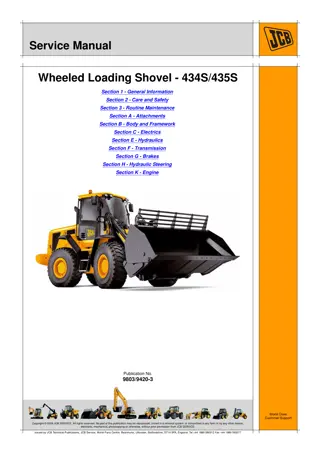





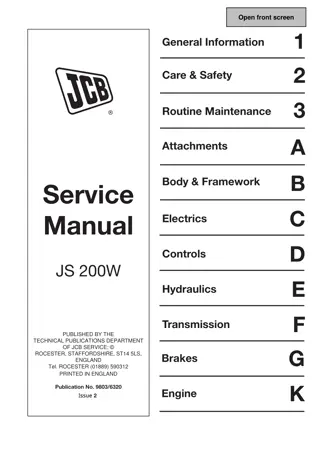

![JCB TM180, TM220 [Engine Deutz] Telescopic Wheeled Loader Service Repair Manual Instant Download](/thumb/98308/jcb-tm180-tm220-engine-deutz-telescopic-wheeled-loader-service-repair-manual-instant-download.jpg)

